News & Blogs
Moon viewing started as aristocracies’ banquet and became an event to show gratitude to the moon for a bountiful harvest.
Offerings to the full moon are made of new crops of the year
Kanto (the Greater Tokyo Area) style versus Kansai (the Greater Osaka Area) style
Other seasonal delicacies associated with the moon viewing
In this blog, we touch on diverse topics about Japanese food cultures, practices together with the culinary secret, TREHA®, and its important role in the Japanese food industry. We hope our blog helps you obtain in-depth knowledge of the secrets and science behind Japanese cuisine, shared from our kitchen, to yours.
As previously mentioned in our past blog articles, the Japanese appreciate seasonal events and customs tied to the four distinctive seasons. One of the well-anticipated autumn events is moon-viewing (月見 tsukimi), to gaze at the beautiful moon on the fifteenth night (十五夜 Jugo-ya) of the period between the end of summer and the start of fall. The moon becomes full in the lunar calendar on the 15th night of every month. Customarily, “Jugo-ya" refers to August 15th in the lunar calendar, which falls on September 10th in 2022. Today, we will talk about "tsukimi," the custom of viewing the harvest moon in the clear fall sky, and foods related to this custom.
Starting as aristocracies' banquets 1000 years ago, moon viewing became an event to express gratitude for a bountiful harvest.
The Japanese have an ingrained concept of considering every natural element as a deity. In particular, since the moon was related to the ebb and flow of the tides, the custom of viewing the moon has been speculated to exist since ancient times. It is commonly believed that the tradition of moon-viewing on the night of August 15 on the lunar calendar began in the Heian period (from the late 9th century onward). Since the Chinese Mid-Autumn Festival (中秋节) was introduced to Japan, moon viewing came to be enjoyed by the aristocracies. Aristocracies in those days did not look up at the sky to gaze at the moon. Instead, they appreciated the moon reflected on the garden pond surface while sipping sake on a boat. During this event, aristocrats would play the elegant poem composition game, which praises the beautiful moon with a music performance that would supposedly continue throughout the night.
The moon banquet among the aristocracies gradually spread to the commoners as the "Jugo-ya Matsuri" festival, which was also tied to wishing or celebrating a bountiful harvest. It is believed that it was in the early Edo period (17th century) that the Jugo-ya festival saturated the commoners. While farmers in the Edo period (17th-19th century) celebrated Jugo-ya as a harvest festival, commoners who were not involved with farming enjoyed gazing at the moon by visiting famous moon-viewing spots on August 15th.
The Japanese appreciating the autumn moon does not merely rely on the psychological effect. There is a scientifically valid reason.
First, autumn air is relatively drier in Japan, which results in the moon being more visible due to less water vapor, which could blur the atmosphere.
Secondly, the moon’s position in the sky creates a visual effect. The moon appears high or low in the sky, depending on the season, due to its orbit relative to the earth. The winter moon appears high in the sky, and the summer moon appears low. When the moon appears low, the dust and light near the earth’s surface inhibit the clarity. Besides, the moon in the lower position will inevitably become dark because the atmosphere absorbs the moonlight.
On the other hand, in winter, the moon appears more clearly as it is less affected by the atmosphere. However, gazing at the moon for a long time on a cold night can be pretty uncomfortable.
Moon gazers are proven to be more comfortable in springs and autumns when the moon appears moderately high in the sky. However, it can be scientifically concluded that autumn is better than spring because spring night air often gets blurred due to seasonal dust, pollen, and yellow sand flown from East Asia.
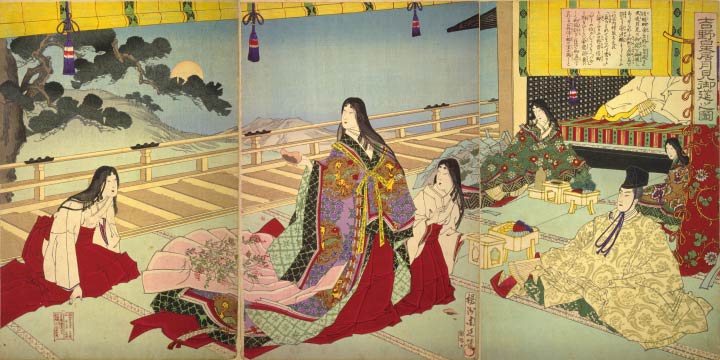
Round-shaped offerings are made to the moon as a token of the gratitude
We explained in our past blog that the Japanese offer round mochi to the New Year’s deity. During a moon-viewing event, the offerings to the moon are displayed by the windows or in the tokonoma alcoves, where artistic items and family heirlooms are displayed.
Japanese silver grass is essential to the offerings because it resembles a rice ear. As mentioned earlier, moon viewing on Jugo-ya is closely related to agriculture. Famers in ancient Japan made offerings of new crops such as potatoes and beans to the moon, a symbol of fertility, appreciating the autumn harvest. Japanese silver grass is a substitute for the rice ear since the rice is still in the pre-fruiting stage on August 15 of the lunar calendar.
The Japanese consider the silver grass to be occupied by a deity because the inside of its stem is hollow, based on Shinto belief. In addition, the sharp cut edge of the grass is believed to have the power to ward off evil.
Thus, the Japanese pray for a good harvest and health for the following year by keeping harmful evils at bay by offering sacred silver grass to the moon. In some areas, people recycle silver grass offered to the moon by hanging it from the roof’s edge to pray for good health.
Another offering is dumplings (月見団子 tsukimi dango).
White, round dumplings resembling a full moon are offered to show gratitude and a prayer for health and happiness. They are believed to have a root in offering rice dumplings to pray for the upcoming harvest. Although the number of dumplings varies from region to region, offering 15 dumplings is common in honor of the Fifteenth Night. Traditionally, round dumplings are stacked in layers like a pyramid on a wood stand with a square pedestal, called a "sanpo (三方)." The pyramid’s tip is thought to be connected to the world beyond. When silver grass or seasonal vegetables and fruits are displayed along with the dumplings, they should be placed on the left side of the dumplings.
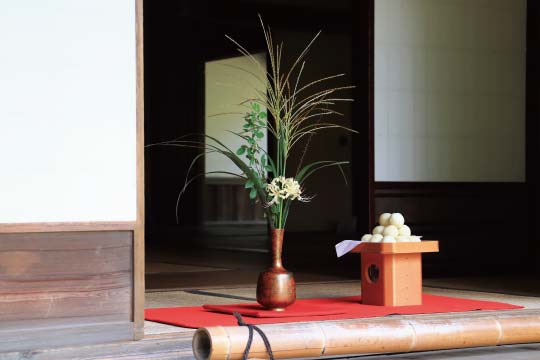
The historical background behind the dumpling shapes in the Kanto (the Greater Tokyo Area) style and Kansai (the Greater Osaka Area) style
The round-shaped dumplings are Kanto (Greater Tokyo area) style. The round rice dumplings supposedly emerged in the latter half of the Edo period (after the mid-18th century), when the commoners of Edo (former Tokyo) began to enjoy moon-viewing.
On the other hand, the counterpart in Kansai (Greater Osaka & Kyoto area) are mochi wrapped with strained and smooth sweet red bean paste (漉し餡 koshian) to resemble taro roots. This is because taro roots were initially offered to the moon based on Chinese moon viewing custom introduced in the late 9th century Kyoto, Japan’s former capital.
The dumplings are often laid out flat, not in a pyramid shape. Even today, the moon on the Jugo-ya is called "Imo Meigetu (芋名月),” meaning “Taro harvest moon” in the Kansai region. The shape of the dumplings represents the 900-year historical background in each area.
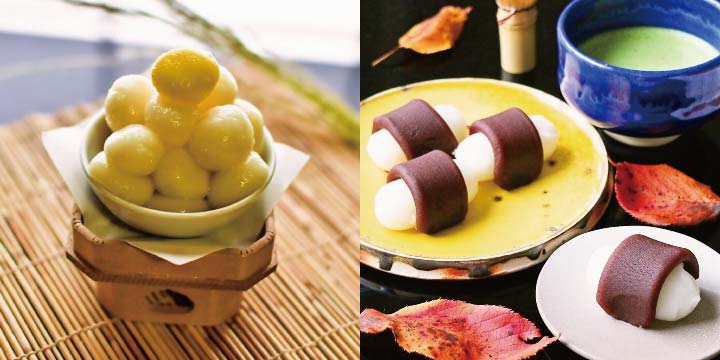
The dumplings come in many other variations featuring distinctive shapes and toppings depending on the region. No matter how various they may look, the idea of offering to the moon to show gratitude is the same throughout Japan. An appropriate alternative is rice dumplings with a sweet soy glaze (みたらし団子 mitarashi dango), which are gaining popularity worldwide.
Click here for the recipe for mitarashi dango using TREHA®. The page features two recipes: a traditional style and a healthy, easy recipe using tofu.
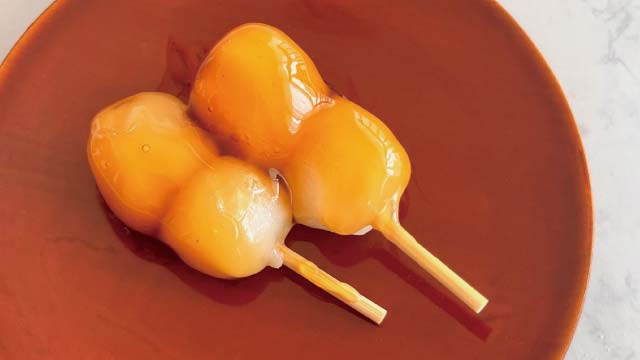
Seasonal delicacies galore for the moon-viewing event
In addition to dumplings, the Japanese enjoy the seasonal delicacies associated with the fifteenth-night moon.
Tsukimi soba (月見そば) and Tsukimi udon (月見うどん): Warm soba noodles and udon noodles with a raw egg, resembling a full moon.
Kinukatsugi (きぬかつぎ): Steamed or boiled taro with the skin. Kinukatsugi, meaning female cover-up kimono from the Heian period (8th-12th century), was named from how the taro is covered with the skin, partially showing a white surface resembling a lady’s face under the kimono.
Satumaimo Gohan (さつまいもご飯) and Kuri Gohan (栗ご飯): Rice cooked with sweet potatoes or chestnuts. Like taro, sweet potatoes and chestnuts harvested in autumn are also offered due to their resemblance to the yellow moon. They are often cooked with rice.
What kind of dish would you create for the moon-viewing event?
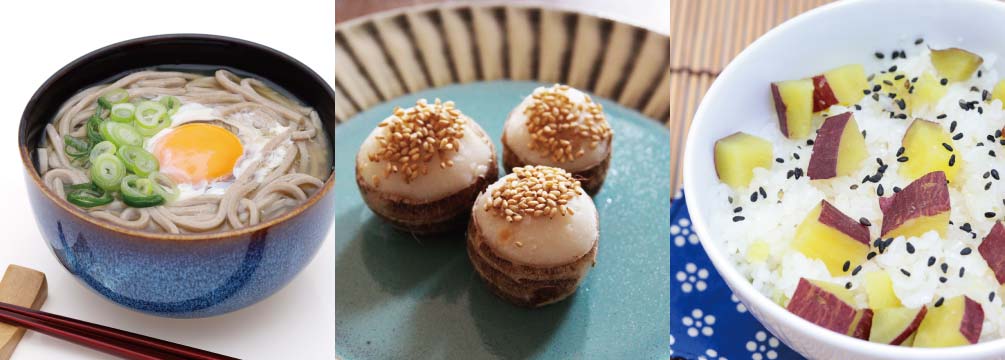
Did you find this blog interesting?
Please share it with your friends in the food service industry.
We regularly update the blog about the food culture of Japan, where TREHA® was discovered for culinary applications.
Click here and send us a message to subscribe.
Or hit us up on Instagram @trehalose_sensei!
You might also be interested in:
Japanese traditional food series 2: Chitose Ame, candy for healthy longevity (千歳飴)
Japanese traditional food series 3: Yuzu (柚子) and the winter solstice
Japanese traditional food series 4: Noodles on New Year's Eve (年越しそば)
Japanese traditional food series 5: Japanese traditional New Year’s dishes, Osechi-ryori (おせち料理)
Japanese traditional food series 6: Another traditional food for New Year’s celebration, mochi (餅)
Japanese traditional food series 13: Inari sushi offered to a deity of harvests

